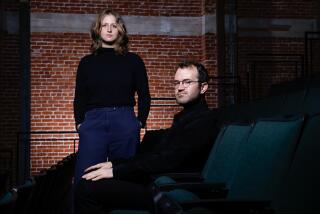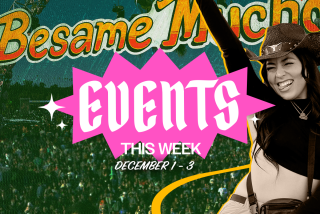Los Angeles Festival / “Home, Place and Memory” / A city-wide arts fest : Gospel According to California: Religious With a Secular Twist : Tonight’s concert at Leimert Park’s Vision Complex kicks off festival.
Bernice Johnson Reagon, Smithsonian Institution scholar of 19th- and 20thCentury sacred music traditions, discovered an interesting thing while preparing a program honoring West Coast gospel music for the 1993 Los Angeles Festival: gospel, according to California, is just a little different from what it was back home.
“California never obeyed rules about musical traditions in the first place--it is one of the first places you get gospel leaping outside of worship and going into television, going into nightclubs,” Reagon mused earlier this week during a conversation in her downtown hotel suite. Reagon, a Georgia native, received her doctorate from Washington’s Howard University before settling there to work for the Smithsonian, where she serves as curator in the division of community life at the institute’s National Museum of American History.
Reagon, who is also a singer and founder of the gospel group “Sweet Honey in the Rock,” is curator of “We’ve Come This Far by Faith,” a celebration of West Coast gospel that kicks off the five-week festival at 8 tonight at Leimert Park’s Vision Complex. This year’s edition of the triennial event focuses on African, African-American and Middle Eastern arts and culture.
Along with the opening performance, featuring a more-than-100-voice choir arranged for the festival, the “Faith” series will include various concerts that pay tribute to gospel legends, including: Rev. Eugene Smallwood; the 1940s a cappella sextet the Paramount Singers, 1950s gospel pioneers Ola Jean Andrews and the Andrews Sisters, and Rev. Albert Goodson.
“One of the stories about California gospel is that you have a regional tradition, which is that of a migration culture,” said Reagon, who was brought in by the festival to do a regionalized mini-version of her ongoing research project on African-American gospel composers for the Smithsonian.
“In the 1930s and ‘40s, people brought their gospel traditions from the South--Alabama, Louisiana, Texas--and from the Midwest: St. Louis, Chicago--that’s the center of classic gospel,” she said. “They bring that music here, but they incubate it in a lifestyle that is new, it’s a new community. So even though the music is from the Midwest, or the East, or wherever, when they finish with it here, it’s going to have a different attitude. California has a different openness to what is possible.”
Reagon said that the California gospel scene helped break down the barriers between secular and religious music, and that West Coast Pentecostal churches were among the first to introduce electronic instruments and other popular culture influences that might have been frowned on by Eastern Baptist churches.
She added that a community-based research project into West Coast traditions uncovered a trend toward large gospel choirs that weren’t attached to a church at all. “It is natural that this is a place where you would get a rich community gospel movement,” said Reagon, “which means that it is not a church choir organization.
“Gospel quartets (in the East) were always like that; they had members from all different churches. But we’re not looking at five or six black men who get together on a Thursday night after working in the steel mills in Birmingham. You are looking at 200, 300 or 400 young people coming together to do mass choir gospel music. That is California.”
And, Reagon adds, “The church ends up being, for black people, bigger than any concept of an organized church. We are talking about something that is alive in the culture. When black people get up in the morning and say, ‘Thank you, Jesus,’ that’s church.”
Reagon believes that tracing the history of gospel music from slavery to the present is crucial not only to understanding African-American music, but American music as a whole. The festival concerts, she said, fit into her dedication to making sure her research reaches the general public, not just the community of scholars.
“It’s teaching Americans about America,” Reagon said. “When you go to Europe, and you talk about American music, everybody talks about African-American music. And that is simply not the case in the U.S. That has to do with racism. Because of racism, this country has tremendous anxiety about embracing its cultural reality.
“Your little teen-agers never take these (headphones) off their ears, and it’s always black music. But if somebody asked you about American music, you might say something about some symphony doing Bach. So one of the important things about these kinds of programs is working with the larger American public to be all right about its cultural reality.”
Although she stresses the importance of the church in African-American history, Reagon was not pleased as she watched news coverage of the 1992 Los Angeles riots, with TV reporters scurrying to predominantly black churches in search of sound bytes and an easy spokesperson for the “black community.”
“I was in Washington, so I watched it, and it was not positive,” Reagon said. “When there is a problem that involves race in this country, and the national media want a voice, going to the black church is trying to establish a line of control . . . ‘These people are tearing up the town, and we don’t want them to do that’--so you use all of your containment strategies. Whether there is a leader or not, we must have a leader, quick, quick! And let’s make the leader as big as possible, fast!
“What I’d like, in (the Los Angeles Festival), is for the media to go to the church to see the people ,” Reagon said. “There, you are not looking for a voice to speak, you are listening to the inside of a people and a history and a community. And for me, that is very different.”
L.A. FESTIVAL
TODAY’S EVENTS
* SHASHMA(California Plaza). Through dance, song and masterful instrumentation on the clarinet, nay (wooden flute), tar (mandolin-like instrument), doire (large tambourine), kettle drums and accordion, this Bukharan Jewish ensemble presents secular and sacred music of the Central Asian steppes, intertwining Muslim and Jewish influences. Noon-1 p.m.
* “CROSSING LA: THE VISUAL ARTS”(Vision Complex, Leimert Park and Museum of African American Art, Baldwin Hills/Crenshaw Plaza). Receptions for curators Roland Charles, Jacqueline Draeger, Ji Young Oh and Craig Cree Stone join selected artists. 6-8 p.m.
* “WE’VE COME THIS FAR BY FAITH: THE WEST COAST GOSPEL TRADITION”(Vision Complex, Leimert Park). Brought together by Bernice Johnson Reagon, Smithsonian Institution curator of African-American culture and founder of Sweet Honey in the Rock, and featuring West Coast gospel legends Ola Jean Andrews and the Andrews Sisters, the Paramount Singers and a Los Angeles choir of 100-plus voices. With tributes to the Rev. Eugene Smallwood, the Rev. Albert Goodson, Doris Akers and others. 8 p.m.
* “CROSSING LA: CIUDAD ADERTRO/ CITY WITHIN”(Vision Complex, Leimert Park). Los Angeles poets Gloria Alvarez & Manuel Luna mix words with the sound-scapes of Collage Ensemble, the minimal postmodern physicality of Hae Kyung Lee and Dancer, and the complex garifuna rhythms of Chatuye to invoke ritual, art and “the vigil of memory” as imperatives for the cultural life and history of peoples. 8 p.m.
* “DOOR TO THE SKY”(Norris Theater, USC). Film by Farida ben Lyazid. A young woman returns to Morocco to pay her respects to her dying father and discovers a spiritual longing to return to her homeland. 7:30 p.m.
* “THE SECRET FACE”(Melnitz Theater, UCLA). Film by Omer Kavur. A photographer searches the city for the face of the one he is compelled to find. “WHERE IS THE FRIEND’S HOME” Film by Abbas Kiarostami. A young student finds that he’s mistakenly taken his classmate’s notebook and begins an arduous odyssey of discovery. 7:30 p.m.
More to Read
The biggest entertainment stories
Get our big stories about Hollywood, film, television, music, arts, culture and more right in your inbox as soon as they publish.
You may occasionally receive promotional content from the Los Angeles Times.










